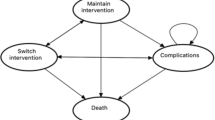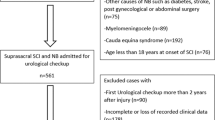Abstract
Objectives:
To present a system of urological care for patients with cervical spinal cord injury (SCI) in the Spinal Cord Unit in Prague.
Methods:
Forty-one out of 412 patients hospitalized with acute SCI between 2007 and 2012 with motor complete SCI (AIS A,B) at the C4–C7 motor level and with sufficient follow-up duration were selected. Patients were trained using a male bladder catheterization model (37 with a transurethral catheter and 4 with a suprapubic catheter) to perform intermittent catheterization (IC) using an ergohand device, and were later encouraged to perform self-catheterization.
Results:
On the basis of the motor level of the SCI, 8 out of the 41 study patients were assigned to group 1 (C4), 11 to group 2 (C5), 15 to group 3 (C6) and 7 to group 4 (C7). All patients in group 1 had an indwelling urinary catheter. In group 2, 6 patients (54.6%) learned to perform IC, with 2 of them needing another person’s assistance. In 5 patients (45.5%), suprapubic cystostomy was maintained (insufficient functional grip, severe autonomic dysreflexia, prompt reflex erection). Group 3 included 12 patients (80%) performing intermittent catheterization and 3 patients (20%) with suprapubic cystostomy (insufficient functional grip, post-bladder-surgery condition, cognitive impairment). In group 4, only 1 patient (14.3%) had an indwelling catheter due to severe abductor spasticity, whereas the remaining 6 (85.7%) learned to perform IC.
Conclusions:
These findings suggest that patients with cervical SCI below the C5 motor level are able to learn self-catheterization, which increases independence and decreases the risk of urinary infection and stone formation.
Similar content being viewed by others
Log in or create a free account to read this content
Gain free access to this article, as well as selected content from this journal and more on nature.com
or
References
Lapides J, Diokno AC, Silber SJ, Lowe BS . Clean, intermittent self-catheterization in the treatment of urinary tract disease. J Urol 1972; 107: 458–461.
Samson G, Cardenas DD . Neurogenic bladder in spinal cord injury. Phys Med Rehabil Clin N Am 2007; 18: 255–274.
Krassioukov A, Warburton DE, Teasell R, Eng JJ., Spinal Cord Injury Rehabilitation Evidence Research Team. A systematic review of the management of autonomic dysreflexia after spinal cord injury. Arch Phys Med Rehabil 2009; 90: 682–695.
Wyndaele JJ, Madersbacher H, Kovindha A . Conservative treatment of the neuropathic bladder in spinal cord injured patients. Spinal Cord 2001; 39: 294–300.
Kirshblum SC, Waring W, Biering-Sorensen F, Burns SP, Johansen M, Schmidt-Read M et al. Reference for the 2011 revision of the International Standards for Neurological Classification of Spinal Cord Injury. J Spinal Cord Med 2011; 34: 547–554.
Doll U, Maurer-Burkhard B, Spahn B, Fromm B . Functional hand development in tetraplegia. Spinal Cord 1998; 36: 818–821.
Di Benedetto P . Clean intermittent self-catheterization in neuro-urology. Eur J Phys Rehabil Med 2011; 47: 651–659.
Asayama K, Kihara K, Shidoh T, Shigaki M, Ikeda T . The functional limitations of tetraplegic hands for intermittent clean self-catheterisation. Paraplegia 1995; 33: 30–33.
Bernuz B, Guinet A, Rech C, Hugeron C, Even-Schneider A, Denys P et al. Self-catheterization acquisition after hand reanimation protocols in c5-c7 tetraplegic patients. Spinal Cord 2011; 49: 313–317.
Acknowledgements
The study was supported by ‘Movement without Help’ foundation.
Author information
Authors and Affiliations
Corresponding author
Ethics declarations
Competing interests
The authors declare no conflict of interest.
Rights and permissions
About this article
Cite this article
Kriz, J., Relichova, Z. Intermittent self-catheterization in tetraplegic patients: a 6-year experience gained in the spinal cord unit in Prague. Spinal Cord 52, 163–166 (2014). https://doi.org/10.1038/sc.2013.154
Received:
Revised:
Accepted:
Published:
Issue date:
DOI: https://doi.org/10.1038/sc.2013.154
Keywords
This article is cited by
-
Urodynamic findings and therapeutic approaches for neurogenic lower urinary tract dysfunction in patients with thoracic spinal cord injury
Irish Journal of Medical Science (1971 -) (2023)
-
Bladder management in individuals with spinal cord injury or disease during and after primary rehabilitation: a retrospective cohort study
World Journal of Urology (2022)
-
Preoperative occupational therapy in children with neurogenic bladder: improving independence with bladder management and self-catheterization
Current Bladder Dysfunction Reports (2022)
-
How many spinal cord injury patients can catheterize their own bladder? The epidemiology of upper extremity function as it affects bladder management
Spinal Cord (2016)
-
Bladder management in individuals with chronic neurogenic lower urinary tract dysfunction
Spinal Cord (2016)



